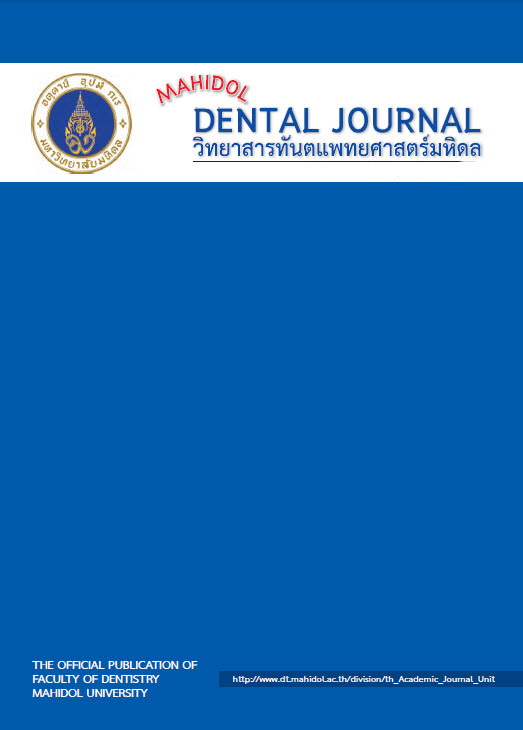The effect of blasting zirconia liner on microtensile bond strength of zirconia to layered and pressed veneers
Main Article Content
Abstract
Objective: To investigate the effect of sandblasting the zirconia liner on the microtensile bond strength of manually-layered and pressed veneers to zirconia
Materials and methods: Bilayered zirconia specimens were prepared from e.max®ZirCAD framework materials and divided into four groups (at least 30 specimens per group). Two veneering techniques were used: I. Layering technique (e.max®Ceram) for group 1 and group 2 and II. Press-on technique (e.max®ZirPress) for group 3 and group 4. ZirLiner was applied onto the zirconia surfaces in group 1 and 3 and fired according to the manufacturer’s instructions. Veneering of these specimens was then performed. The surfaces of group 2 and 4 were treated similarly to group 1 and 3, except that sandblasting with 50-μm aluminum oxide particles was performed on the fired liner material. The bilayered blocks were cut into microbars with 1mm x 1mm in cross-section. All specimens were loaded to fracture using a microtensile tester. The fracture surfaces were analyzed using a scanning electron microscope to identify the mode of failure.
Results: When the liner material was blasted, the mean microtensile bond strength (MTBS) of bilayered specimens in the layering group (14.5±2.7 MPa) and the press-on group (15.5±5.0 MPa) were significantly lower than those of unblasted liner groups (16.5±3.5 MPa for layering and 19.8±6.1 MPa for press-on). Most of the fractures occurring in all groups initiated at the zirconia-veneer interface.
Conclusions: Blasting the zirconia liner material decreased the bond strength between zirconia to layered and pressed veneers. Interfacial failure was predominantly observed in all groups.
Article Details
References
2. Nikzad S AA, Dehgan S. Ceramic (Feldspathic & IPS Empress II) versus laboratory composite (Gradia) veneers: a comparison between their shear bond strength to enamel: an in vitro study. J Oral Rehabil 2010;37:569-74.
3. Aboushelib MN, Kleverlaan CJ, Feilzer AJ. Microtensile bond strength of different components of core veneered all-ceramic restorations. Part II: Zirconia veneering ceramics. Dent Mater 2006;22:857-63.
4. Aboushelib MN, de Jager N, Kleverlaan CJ, Feilzer AJ. Microtensile bond strength of different components of core veneered all-ceramic restorations. Dent Mater 2005;2:984-91.
5. Sailer I FA, Filser F, Lüthy H, Gauckler LJ, Schärer P, Hämmerle CHF. Prospective clinical study of zirconia posterior fixed partial dentures: 3-year follow-up. Quintessence Int 2006;37:41-9.
6. Sailer I, Feher A, Filser F, Gauckler LJ, Luthy H, Hammerle CH. Five-year clinical results of zirconia frameworks for posterior fixed partial dentures. Int J Prosthodont 2007;20:383-8.
7. Scurria MS BJ, Shugars DA. . Meta-analysis of fixed partial denture survival: Protheses and abutments. J Prosthet Dent 1998;79:459-64.
8. Creugers NH, Kayser AF, van 't Hof MA. A meta-analysis of durability data on conventional fixed bridges. Community Dent Oral Epidemiol 1994;22:448-52.
9. Heffernan MJ AS, Diaz-Arnold AM, et al Relative translucency of six all-ceramic systems. Part II: core and veneer materials. J Prosthet Dent. 2002;88:10-5.
10. Aboushelib MN, Kleverlaan CJ, Feilzer AJ. Effect of zirconia type on its bond strength with different veneer ceramics. J Prosthodont 2008;17:401-8.
11. Nakamura T WK, Zaima C, Nishida H, Kinuta S, Yatani H. . Tensile bond strength between colored-porcelain and sandblasted zirconia framework. J Prosthodont Res 2009;53:116-9.
12. Harding AB NB, Teixeira EC. The Effect of Surface Treatment of the Interfacial Surface on Fatigue-Related Microtensile Bond Strength of Milled Zirconia to Veneering Porcelain. J Prosthodont 2012;21:346-52.
13. Vigolo P MS. Evaluation of zirconium-oxide-based ceramic single-unit posterior fixed dental prostheses (FDPs) generated with two CAD/CAM systems compared to porcelain-fused-to-metal single-unit posterior FDPs: a 5-year clinical prospective study. J Prosthodont 2012;21:265–9.
14. Örtorp A, Kihl ML, Carlsson GE. A 5-year retrospective study of survival of zirconia single crowns fitted in a private clinical setting. J Dent 2012;40:527–30.
15. Kern T TJ, Schley JS, Wolfart S. . Five-year clinical evaluation of all-ceramic posterior FDPs made of In-Ceram zirconia. Int J Prosthodont 2012;25:622–4.
16. Isgro G, Wang H, Kleverlaan CJ, Feilzer AJ. The effects of thermal mismatch and fabrication procedures on the deflection of layered all-ceramic discs. Dent Mater 2005 ;21:649-55.
17. Manicone PF, Rossi Iommetti P, Raffaelli L. An overview of zirconia ceramics: basic properties and clinical applications. J Dent 2007;35:819-26.


